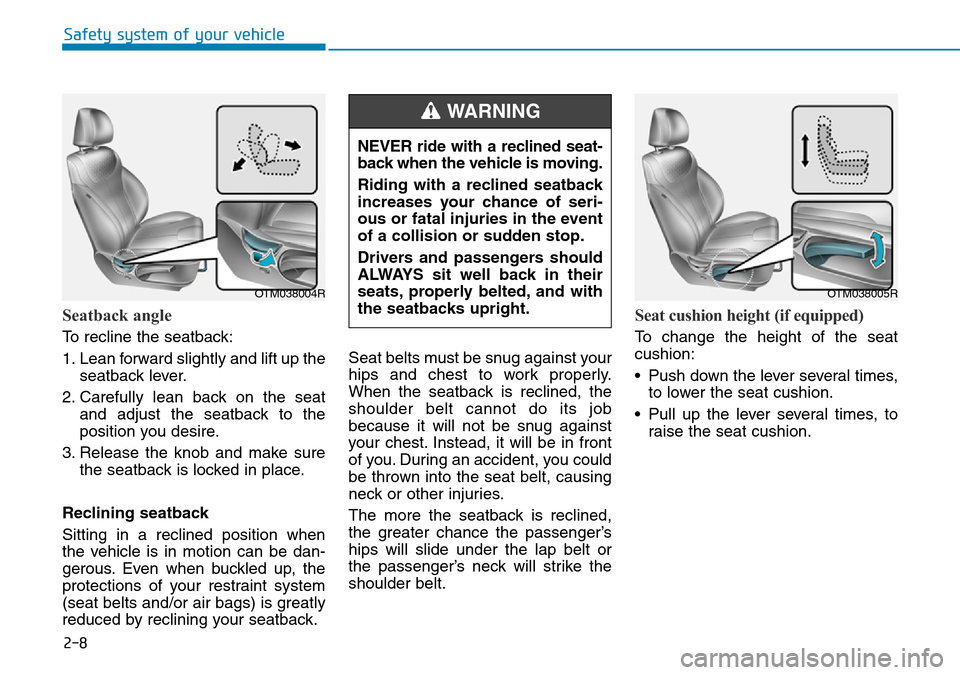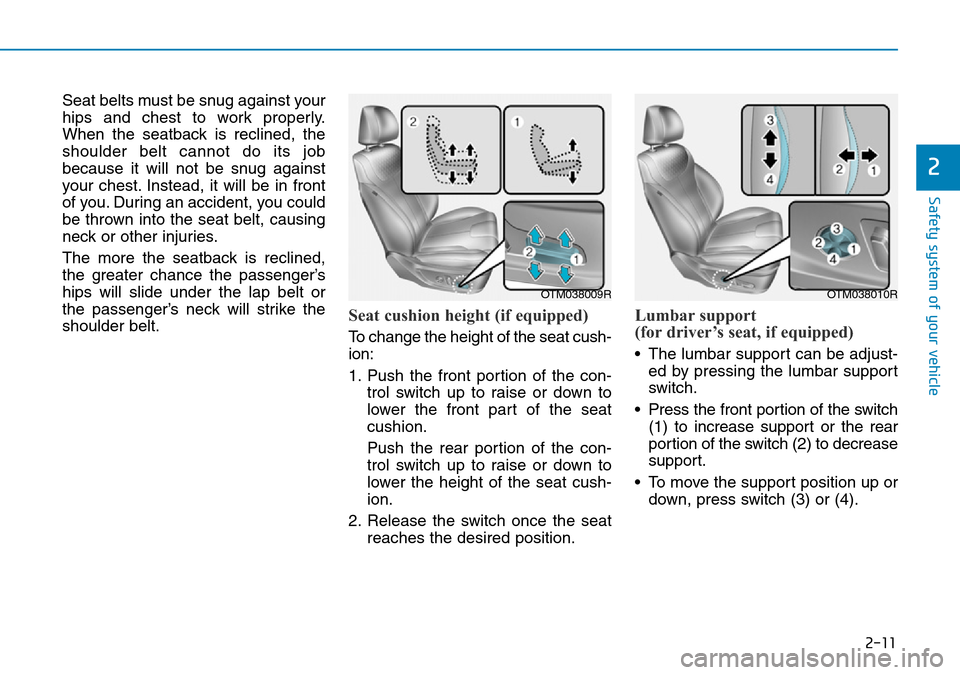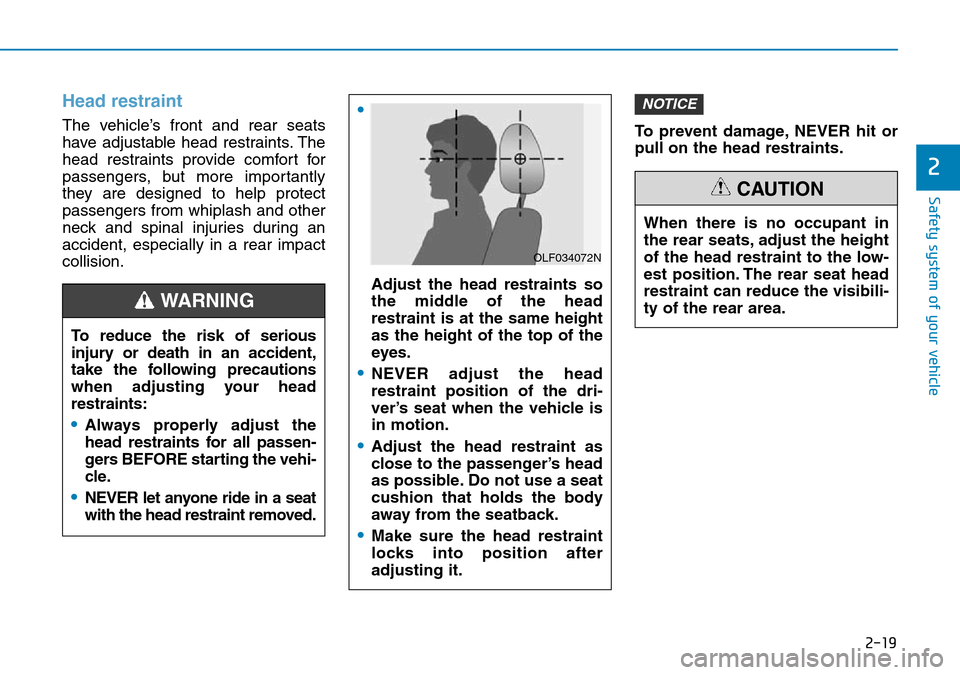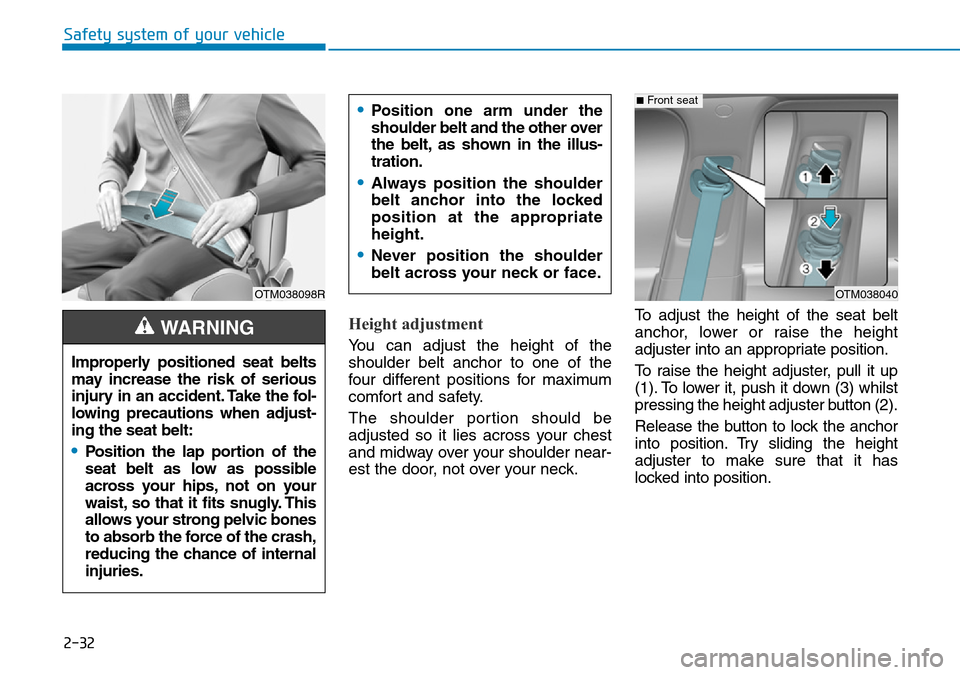Page 25 of 682
2-4
Safety system of your vehicle
SEATS
Front seat
(1) Forward and backward
(2) Seatback angle
(3) Seat cushion angle
(4) Seat cushion height
(5) Seat cushion length
(6) Lumbar support (Driver’s seat)
(7) Seat warmer
(8) Air ventilation seat
(9) Head restraint
(10) Passenger seat adjustment
(seat sliding, seatback angle)
2
ndrow seat
(11) Forward and backward
(12) Seatback angle
(13) Walk-in switch
(14) Head restraint
(15) Seat warmer
(16) 2
ndrow seat remote folding switch
3
rdrow seat
(17) Seatback folding
(18) Head restraint
OTM038001R
Page 29 of 682

2-8
Safety system of your vehicle
Seatback angle
To recline the seatback:
1. Lean forward slightly and lift up the
seatback lever.
2. Carefully lean back on the seat
and adjust the seatback to the
position you desire.
3. Release the knob and make sure
the seatback is locked in place.
Reclining seatback
Sitting in a reclined position when
the vehicle is in motion can be dan-
gerous. Even when buckled up, the
protections of your restraint system
(seat belts and/or air bags) is greatly
reduced by reclining your seatback.Seat belts must be snug against your
hips and chest to work properly.
When the seatback is reclined, the
shoulder belt cannot do its job
because it will not be snug against
your chest. Instead, it will be in front
of you. During an accident, you could
be thrown into the seat belt, causing
neck or other injuries.
The more the seatback is reclined,
the greater chance the passenger’s
hips will slide under the lap belt or
the passenger’s neck will strike the
shoulder belt.
Seat cushion height (if equipped)
To change the height of the seat
cushion:
• Push down the lever several times,
to lower the seat cushion.
• Pull up the lever several times, to
raise the seat cushion.
OTM038004R
NEVER ride with a reclined seat-
back when the vehicle is moving.
Riding with a reclined seatback
increases your chance of seri-
ous or fatal injuries in the event
of a collision or sudden stop.
Drivers and passengers should
ALWAYS sit well back in their
seats, properly belted, and with
the seatbacks upright.
WARNING
OTM038005R
Page 32 of 682

2-11
Safety system of your vehicle
2
Seat belts must be snug against your
hips and chest to work properly.
When the seatback is reclined, the
shoulder belt cannot do its job
because it will not be snug against
your chest. Instead, it will be in front
of you. During an accident, you could
be thrown into the seat belt, causing
neck or other injuries.
The more the seatback is reclined,
the greater chance the passenger’s
hips will slide under the lap belt or
the passenger’s neck will strike the
shoulder belt.
Seat cushion height (if equipped)
To change the height of the seat cush-
ion:
1. Push the front portion of the con-
trol switch up to raise or down to
lower the front part of the seat
cushion.
Push the rear portion of the con-
trol switch up to raise or down to
lower the height of the seat cush-
ion.
2. Release the switch once the seat
reaches the desired position.
Lumbar support
(for driver’s seat, if equipped)
• The lumbar support can be adjust-
ed by pressing the lumbar support
switch.
• Press the front portion of the switch
(1) to increase support or the rear
portion of the switch (2) to decrease
support.
• To move the support position up or
down, press switch (3) or (4).
OTM038009ROTM038010R
Page 40 of 682

2-19
Safety system of your vehicle
2
Head restraint
The vehicle’s front and rear seats
have adjustable head restraints. The
head restraints provide comfort for
passengers, but more importantly
they are designed to help protect
passengers from whiplash and other
neck and spinal injuries during an
accident, especially in a rear impact
collision.To prevent damage, NEVER hit or
pull on the head restraints.
NOTICE
To reduce the risk of serious
injury or death in an accident,
take the following precautions
when adjusting your head
restraints:
•Always properly adjust the
head restraints for all passen-
gers BEFORE starting the vehi-
cle.
•NEVER let anyone ride in a seat
with the head restraint removed.
•
Adjust the head restraints so
the middle of the head
restraint is at the same height
as the height of the top of the
eyes.
•NEVER adjust the head
restraint position of the dri-
ver’s seat when the vehicle is
in motion.
•Adjust the head restraint as
close to the passenger’s head
as possible. Do not use a seat
cushion that holds the body
away from the seatback.
•Make sure the head restraint
locks into position after
adjusting it.
WARNING
OLF034072N
When there is no occupant in
the rear seats, adjust the height
of the head restraint to the low-
est position. The rear seat head
restraint can reduce the visibili-
ty of the rear area.
CAUTION
Page 41 of 682
2-20
Safety system of your vehicle
Front seat head restraints
The driver’s and front passenger’s
seats are equipped with adjustable
head restraints for the passengers
safety and comfort.
Adjusting the height up and down
To raise the head restraint:
1. Pull it up to the desired position
(1).
To lower the head restraint:
1. Push and hold the release button
(2) on the head restraint support.
2. Lower the head restraint to the
desired position (3).
Forward and rearward adjustment
(if equipped)
The head restraint may be adjusted
forward to 3 different positions by
pulling the head restraint forward to
the desired detent. To adjust the
head restraint to it’s furthest rear-
wards position, pull it fully forward to
the farthest position and release it.
OHM038048N
OTM038012OTM038011
Page 43 of 682
2-22
Safety system of your vehicle
To reinstall the head restraint :
1. Recline the seatback.
2. Put the head restraint poles (2) into
the holes whilst pressing the
release button (1).3. Adjust the head restraint to the
appropriate height.
4. Recline the seatback (4) the seat-
back angle knob or switch (3).
Rear seat head restraints
(2nd,3rdrow rear seat)
The rear seats are equipped with
head restraints in all the seating
positions for the passenger’s safety
and comfort.
OTM038097L* : if equipped
Always make sure the head
restraint locks into position after
reinstalling and adjusting it prop-
erly.
WARNING
OTM038016R
OTM038014R
■Type A
■Type B
Page 44 of 682
2-23
Safety system of your vehicle
2
Adjusting the height up and down
To raise the head restraint:
1. Pull it up to the desired position (1).
To lower the head restraint:
1. Push and hold the release button
(2) on the head restraint support.
2. Lower the head restraint to the
desired position (3).
Removal and installation
To remove the head restraint :
1. Raise it as far as it can go.
2. Press the release button (1) whilst
pulling upward (2).
To reinstall the head restraint :
1. Put the head restraint poles (3)
into the holes whilst pressing the
release button (1).
2. Adjust the head restraint to the
appropriate height.
OTM038023OTM038024
•Adjust the head restraints so
the middle of the head
restraint is at the same height
as the height of the top of the
eyes.
•When sitting on the rear seat,
do not adjust the height of the
head restraint to the lowest.
CAUTION
Page 53 of 682

2-32
Safety system of your vehicle
Height adjustment
You can adjust the height of the
shoulder belt anchor to one of the
four different positions for maximum
comfort and safety.
The shoulder portion should be
adjusted so it lies across your chest
and midway over your shoulder near-
est the door, not over your neck.To adjust the height of the seat belt
anchor, lower or raise the height
adjuster into an appropriate position.
To raise the height adjuster, pull it up
(1). To lower it, push it down (3) whilst
pressing the height adjuster button (2).
Release the button to lock the anchor
into position. Try sliding the height
adjuster to make sure that it has
locked into position.
OTM038098R
Improperly positioned seat belts
may increase the risk of serious
injury in an accident. Take the fol-
lowing precautions when adjust-
ing the seat belt:
•Position the lap portion of the
seat belt as low as possible
across your hips, not on your
waist, so that it fits snugly. This
allows your strong pelvic bones
to absorb the force of the crash,
reducing the chance of internal
injuries.
WARNING
•Position one arm under the
shoulder belt and the other over
the belt, as shown in the illus-
tration.
•Always position the shoulder
belt anchor into the locked
position at the appropriate
height.
•Never position the shoulder
belt across your neck or face.
OTM038040
■Front seat